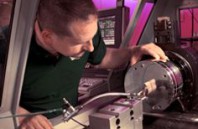Syntec optics is manufacturing Polymer optics, Plastic injection moulding and biometrics devices and components by the diamond turning process.
Diamond turning is an important process to create precision elements through diamond-tipped lathes or various other machine tools. In general, multiple lathes are used which are controlled by computers. However, diamond-tipped lathes are not particularly implemented on metals such as steel, and routine checkup is essential throughout the cutting process to ensure precision. The straightforward trait of diamond turning is its principal problem since a major volume of faulty components is manufactured.
Diamond turning produces aspheric optical components from materials such as metal and crystal, which further produces a variety of scientific products such as telescopes, scientific gadgets, and missile guidance systems. The majority of diamond turning is performed by tools such as lathes, which are controlled by computers.
In fact, diamond turning process has a variety of phases. In general, multiple CNC lathes are also part of the process, each more accurate than the final one. In the due course of the process, a lathe included with diamond tipped is incorporated to determine a heightened level of accuracy. Each phase is closely kept track of with the help of laser equipment and electron microscopes.
The diamond turning lathe is put on a granite-made stand sporting a remarkably unsullied surface finish. This stand is next put on the top of air suspension, to make sure the work surface can stay horizontal. The machine components are put on the granite base having hydraulic deferral to determine the accuracy level. Negative air pressure hook up the machined component to an air chuck. Another air suspension determines that the chuck is set at a distance apart from the electric motor, which lets it to rotate.
Electric motors are typically used when it comes to cut the tool. A computer regulates the tools movements. The intensity of the cutting passes enhances until the ending surface is completed.
Despite the fact that the entire process is regulated by the computer, the role of a manual monitor still stands to reason. Ensuring the premium quality is the major objective of this technique, and as a result of this, a test is typically followed out at every phase of the process.
Syntec Optics has been a global leader in the industry of polymer optics successfully for over 3 decades. Our production includes biomedical imaging, microfluidics chips, Diamond turning,Polymer optics,plastic injection moulding,biometrics, Led optics & lighting and more. Visit the website to get complete pull of knowledge about our manufacturing products.

 (585) 768-2513
(585) 768-2513

